Cleaning sewer pipes: analysis of the best ways to clear pipes from blockages
There are several reasons why blockages form in sewer pipes: improper installation, careless operation of the sewer system, old pipes.But the consequences are always the same - a plug appears, which impedes the normal movement of wastewater.
In this case, urgent sewer pipe cleaning is needed. Next, we will explain in detail what tools and technologies are required.
The content of the article:
3 signs of sewer problems
If grates are not installed on the sink drain holes, household waste gets into the siphons and pipes, and grease settles on the walls. Sooner or later, the thickness of the layer becomes such that dirt interferes with the free passage of liquid and any solid particles can tightly clog the pipes.
There are several signs by which you can identify problems with the system:
- Sewer stench. Waste that accumulates on the walls of pipes emit a characteristic unpleasant odor. It enters the room and poisons the air. If appeared smell from drain sinks or bathtubs, action should be taken as quickly as possible.
- Slow drainage of water. If the liquid does not flow well, it means that too much deposits have accumulated on the walls of the pipes. It's time to remove them. Often this is as easy as pouring a bucket of boiling water down the sink. The fat will dissolve and go further down the drain.
- Complete stop of the device. If water has completely stopped flowing into the sewer system, it’s time to take up the plumbing cable, because... Half measures will not do here, and special chemistry is unlikely to be effective.
The most common drains to clog are food waste, hair, grease, and dissolved detergents. Such traffic jams can be liquidate yourself, without the help of plumbers with special tools.
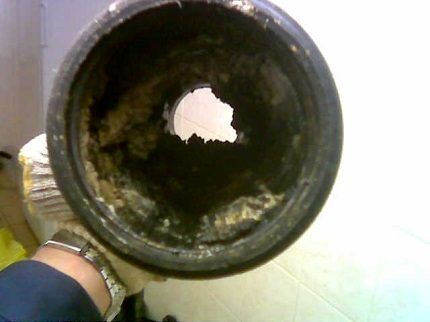
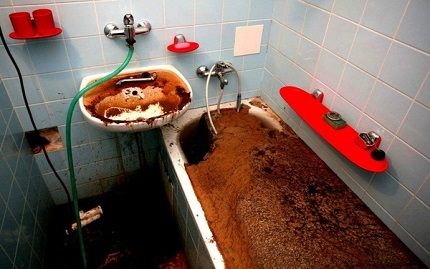
If the blockage completely blocks the pipes, water begins to accumulate in the sink or bathtub and overflows. This may result not just in the cost of a plumber's services, but also in a complete renovation of the bathroom.
You shouldn’t bring the system to this state; it’s better to immediately respond to the “first bells.” It's cheaper.
Mechanical and chemical cleaning of pipes
If the blockage is caused by a solid object getting into the system, you will have to invite specialists to clean the sewer pipes. They use their own tools and equipment - long, high-strength cables and special machines, incl. pneumatic, drilling, root cutting.

Less serious blockages can be eliminated yourself - using cables, plungers, and special household chemicals for cleaning drains. The most reliable device that can cope with almost any traffic jam is a plumbing cable.
It saves in situations where other means are useless. But simple blockages can be eliminated using plungers or chemicals.
Option 1: plumbing cable
This is a universal tool for cleaning drains. It is made from a metal spring. Due to the large length of the cable, it may be difficult to hold and turn it, so manufacturers pay attention to the handles of their models. Nozzles are attached to the working part of the cable, thanks to which you can destroy any dirt plugs.
When choosing a tool, the following criteria are of fundamental importance:
- Diameter. It is selected depending on the diameter of the sewer pipes.
- Length. The variety of models is huge. Their length can vary from 2-3 to 45-60 m. You should decide on the purpose of use and choose the most convenient tool.
- View. There are several types of models. To choose the right one, you should take into account the features of the sewer system.
- Strength. When choosing a cable, special attention is paid to quality. Savings are not appropriate here, because... a good tool will last for several decades.
- Material. It is better to give preference to thick galvanized steel, especially if you plan to purchase a spring model. Weak springs often straighten out, making them difficult to operate.
- Handle shape. The handle of the cable should fit snugly in the palm, because you will have to make an effort to turn the tool in the pipe. For long cables, the ideal shape is a curved shaft. It is best that the handle slides over the tool and can be fixed in any convenient place.
In addition to traditional mechanical cables, there are also electrical ones. The principle of their operation is the same: the tool is pushed into the sewer pipes and with its help, the blockage is destroyed. The difference is that the cable is pushed into the pipe not manually, but using an electric drive.
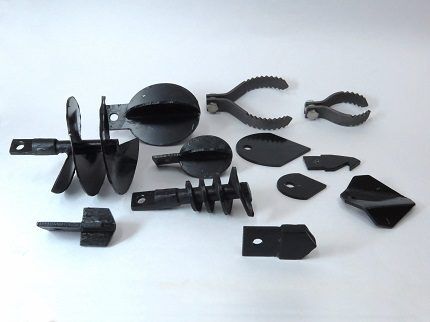
The electric cable is not difficult to use. To figure out how to properly clean a sewer pipe, just read the instructions.
When the tool nozzle reaches the plug, you need to change the speed of the trigger mechanism in order to effectively destroy deposits and not damage the system elements. Special plumbing machines work on approximately the same principle.
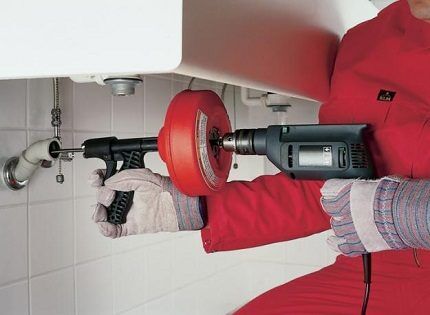
The technology for cleaning pipes with a cable is the same regardless of the type of tool:
- Inspection. Before starting work, you should inspect the plumbing tool, make sure there is no serious damage and that the handle is securely fastened. This is important because if the cable or part of it comes off during cleaning, the situation will only get worse, and a regular blockage will seem like a small thing compared to the need to extract a smooth metal tool from the pipe.
- Preparation. You need to choose the right nozzle and firmly fix it on the end of the cable. If the same permanent attachment is used, ensure that it is securely attached and not damaged. If necessary, lubricate the handle bushings.
- Pipe cleaning. If a blockage has formed in the sink, you should remove the siphon to avoid damage.If possible, remove all plastic parts. After this, the end of the cable is inserted into the pipe, rotated, gradually pushing deeper. Sometimes you need to take out the tool, clean it and push it further down the drain again.
- Clearing the blockage. When the tool hits an obstacle, you need to reduce the rotation speed, make sure that it is a blockage and not a rotation of the pipe, and destroy the plug with quick, gentle movements. If possible, it is better to hook the clog and pull it out. If not, push forward.
- Shutdown. When the patency of the pipe is restored, you need to rinse it with hot water. This will help get rid of grease and dirt in the system. At first, the tap is opened only a little, and then the pressure is increased to the maximum. The main thing is that the water flows freely through the drain.
An important sign that everything was done correctly is the swirl of water as it flows into the drain. If a crater forms, it means that the pipe walls have become clean and smooth. If the water flows out weakly, you should repeat the cleaning with a cable, and after that, rinse the sewer with boiling water, special chemicals, soda or citric acid.
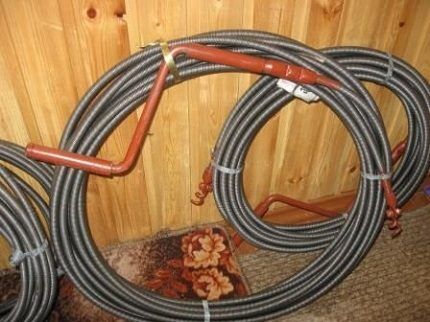
To Work with plumbing cable It's not difficult, but sometimes there are troubles. If the pressure is too strong, there is a risk of breaking the plastic pipe or damaging any element of the system. Therefore, you need to act carefully: it is better to “under-press” than to “over-press”.
If the tool gets stuck when pushing forward, sudden movements are generally excluded: it is necessary to slowly “loose” it from side to side until the pressure weakens.
Option 2: plunger and its analogues
Many people are interested in how to clear a simple blockage in a pipe if there is no cable? You can try to deal with the traffic jam using a plunger. The tool consists of a rubber or silicone cap and handle.
Its advantages:
- Versatility. Can be used for any plumbing fixtures.
- Safety. The plunger does not damage the plastic. Unlike a cable, there is no risk that the working part of the tool will come off the handle and remain inside the pipe.
- Practicality. The device is easy to wash, dry and use.
- Compactness. The plunger takes up minimal space. There are collapsible models that are even more convenient to store.
- Cheapness. A mechanical plunger is inexpensive compared to metal cable, plumber's wire or tape.
The operating principle of the device is based on creating the effect of water hammer, which occurs during translational movements of the device. This allows you to move the blockage plug from its place, destroy it and move it further along the pipe.
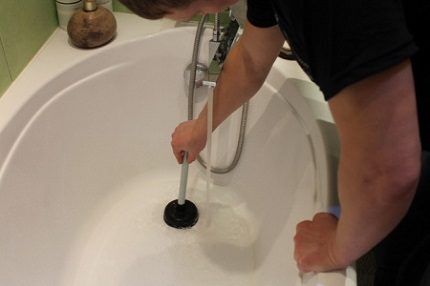
Although the use of plungers is almost unlimited, it is worth buying separate devices for sinks and toilets. This will allow you not to worry about maintaining hygiene standards and even save a little.
It is not necessary to buy two expensive models, because a device of the most modest size is sufficient to clean the sink drain. But for the toilet it is better to choose a plunger with a large rubber cap.
If you don’t have a toilet plunger, you can replace it with improvised means if the blockage is not very far along the pipe. Not a bad alternative - plastic bottle volume 1.5-2 l.Dimensions should be selected depending on the diameter of the toilet flush.
The bottom of the bottle is cut off and used in the same way as a plunger, pumping water up and down. Water hammer will destroy the blockage and the water will go down the drain.
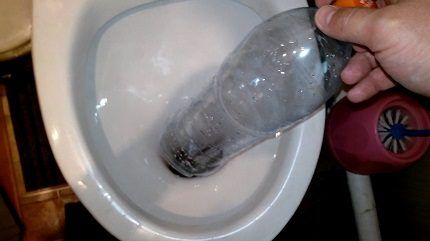
When the toilet is clogged, sometimes even an ordinary rag or a familiar brush-brush is used instead of a plunger. Chinese (also called Korean) film deserves special attention.
If other methods are ineffective against serious traffic jams, then with the help of film you can clean the toilet pipes very efficiently, because high pressure is created and a powerful stream of water lifts dirt from the inner walls.
Option 3: soda and special chemicals
Chemical sewer cleaning has one major drawback: it cannot be used if the pipes are tightly clogged. This applies to both store-bought products and traditional soda.
If the sewer is clogged tightly, and there is water in the sink, bathtub or toilet, it is useless to add or pour in any chemicals, because... it will not reach the blockage or the concentration will be insufficient.
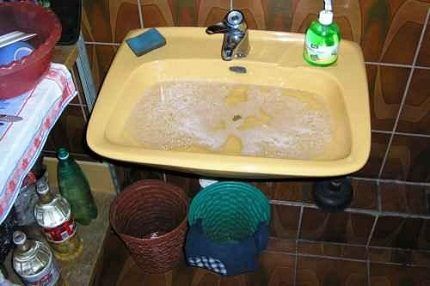
Some owners decide to remove the siphon, drain the water and pour chemicals directly into the sewer pipe. This may work, but it's better to use a cable because... the probability of success is higher.
With chemistry it is better to act for sure. It is effective if the blockage is simple, is located relatively close to the drain, and water, although weakly, flows through the pipe.

When choosing chemicals pay attention to the composition and intended purpose. Acid-based preparations are more appropriate in the kitchen, because... best for breaking down fats.
And for the bath and toilet, it makes sense to choose an alkaline product that copes well with soap residues and dissolves hair and fur.
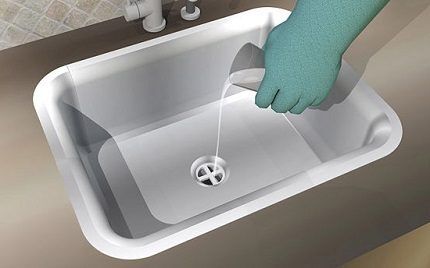
The form of release also matters. Powder and granular formulations are considered more aggressive and caution should be used when using them.
Liquid and gel-based products are safer for plastic pipes. However, you shouldn’t relax and leave them on all night, because... Increasing the duration of action does not at all guarantee an improvement in the result, but can cause damage.
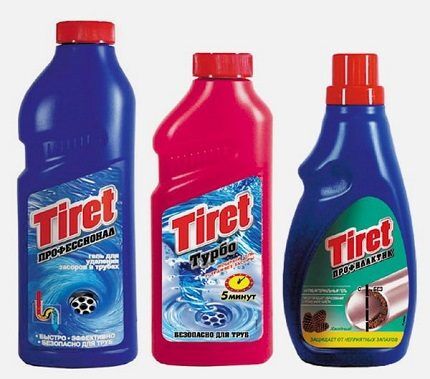
Chemistry is a simple but dangerous method of dealing with blockages. Aggressive substances end up in the sewer system and then in the environment.In addition, fumes can cause allergies and provoke respiratory diseases.
It is better to choose an environmentally friendly composition - baking soda (can be combined with vinegar or salt).

Let's look at how you can clean a sewer pipe with soda and remove deposits from the walls:
- Pour half a pack of baking soda into the drain, pour in a glass of white vinegar and plug the hole with a rag.
- A violent chemical reaction should begin. You should wait for it to finish.
- When the composition stops hissing and foaming, you can take out a rag and run hot water over the pipes.
This method is simple, suitable not only for combating blockages, but also for prevention.
Conclusions and useful video on the topic
Methods for cleaning sewer pipes are not limited to those listed. There are many other methods that can be successfully applied in your home. We offer the most interesting materials on the topic.
Review of popular methods for clearing clogs:
Stores sell special attachments for cables, but you can make them yourself if you use the following tips:
A plunger can save you in the most unpleasant situations. How to use it is described below:
There are interesting folk recipes on how to prepare a caustic solution from soda, which is as effective as store-bought products. We offer step-by-step video instructions:
All methods of cleaning sewer pipes are good in their own way. It is worth choosing one or more suitable products and using them as needed.Don’t forget about preventive measures: watch what goes down the drain, use drain nets and regularly flush the pipes with soda or chemicals.
Clean sewerage is the key to a comfortable life.
Do you know other effective ways to clean drains and use them successfully? Or maybe you found shortcomings in the material presented or want to ask a question about the topic of the article? Please write your comments in the block below.




Initially, when installing a sewer system, you need to use pipes of a slightly larger diameter and make the slopes of the structures steeper. Then they will clog once every 25 years. And for cleaning there is nothing better than a cable and a brush. Chemistry is nonsense, not worthy of attention. Well, the best option is to dismantle the system and clean the pipes every five to ten years. Moreover, modern designs made of plastic pipes and fittings allow this to be done quickly.
And how many people do you know who, for the sake of prevention, dismantle pipes and clean them? Until the blockage is firmly established, no one will do this.
By and large, this is what happens, no preventive work or preventive measures, just a blockage that forces you to act! Unfortunately, many people do this. But regarding preventive cleaning and flushing of risers, I don’t agree with you.
This is exactly what the relevant representatives of the management company of the apartment building should do. This must be clearly stated in the contract. And this is regulated by the rules and regulations for the technical operation of the housing stock.
Cleaning and flushing of sewer risers should be done at least once a year. In addition, certificates of completion of the relevant work must be completed and signed.
These are the collective farmers who will advise and put on more and cooler ones. Everything has its own dimensions and requirements. Taken, by the way, not out of thin air, but technically justified. When everything is done properly, it lasts for decades for private use. And some already after five, and some after a year, clean and think that this is normal. Well, like a sewer.
I’ll tell you from my own bitter experience, if there is a problem, call a plumber with normal equipment. It will solve faster and more reliably. I had a story: a pipe in the kitchen was clogged, I started cleaning it myself, the blockage seemed to go away, a day later it happened again, then nothing happened. Moreover, water came to me from the neighbors above. That is, the blockage was not only mine, but also in the main pipe. In total, the kitchen flooded. I won’t talk about communication with the management company, it’s empty. I tried to solve it myself. In apartment buildings, by the way, this is tough. To tackle the riser, you need to gather all the neighbors throughout the riser. To monitor the water in your area during work. Then he called the utility workers. They fixed it with a mechanical cable, attention, in 12 minutes! If I had called earlier, I would have saved a lot of nerves and time! There is a problem, the door is to a professional!